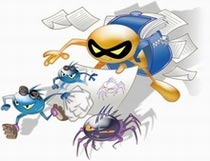Trojan forged Microsoft security warnings
A spam attack campaign impersonating Microsoft's security warning message has just been booted by hackers with the goal of tricking users into downloading and installing a dangerous trojan.
Emails often take the title of a fake " Cumulative Security Update for Internet Explorer " that provides a dangerous patch for Internet Explorer. There are specific links that allow users to download patches.
If the user clicks on the link they will be connected to a remote server and download a trojan called Trojan-Downloader.Win32.Agent.avk . The main function of this trojan is to bridge many other types of malware into the infected system.
 Researcher Lenny Zeltser of SANS Internet Storm Center - the company that discovered the attack - identified the target of hackers in this phishing campaign could be the domain names and servers they need to continue. expand the attack.
Researcher Lenny Zeltser of SANS Internet Storm Center - the company that discovered the attack - identified the target of hackers in this phishing campaign could be the domain names and servers they need to continue. expand the attack.
These types of attacks are still tricking many users. Often, users are not aware of the differences between a fake and a fake warning message even if a fake product contains errors that are easily detected.
Users need to be aware that Microsoft never sends alert messages via email before it releases monthly updates. In addition, the link to the patch will lead the user to the main page that provides complete information about the patch, not a file.
Hoang Dung
 OpenOffice worm attacks the operating system
OpenOffice worm attacks the operating system 10,000 websites were attacked
10,000 websites were attacked The virus extends money to phone users
The virus extends money to phone users 115,000 telephones fall victim to mobile viruses
115,000 telephones fall victim to mobile viruses Dangerous software on YouTube
Dangerous software on YouTube Deep 'Harry Potter died' spread strongly
Deep 'Harry Potter died' spread strongly